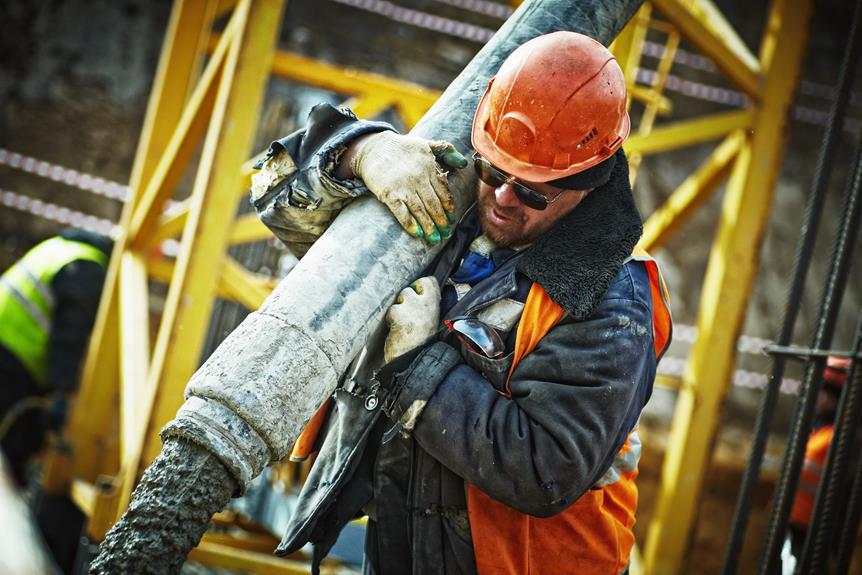Deadly Work Injuries Soar: Are You Protected
In an era of escalating workplace injuries, understanding protection measures is paramount. This article scrutinizes the prevalence of work-related injuries across various industries, the significance of adequate safety training, and the employer's responsibility in prevention. It further discusses the crucial role of a workers' compensation attorney and the pathway to financial recovery. A comprehensive knowledge of these aspects can empower workers, fostering a safer work environment and equipping them to handle unfortunate incidents.

Key Takeaways
- Common types of work-related injuries include broken bones from falls, head trauma from car crashes, third-degree burns from chemical explosions, and overexertion leading to pain and discomfort.
- Lack of training can lead to costly injuries, low morale, and high turnover rates. Proper training ensures a safe work environment for employees and employers.
- Employers can be held responsible for workplace injuries, with thousands of workers being seriously injured or killed on the job every year.
- Hiring a workers' comp attorney who knows the law well can ensure proper treatment and settlement for injured workers, as well as provide guidance and representation in workers' compensation cases.
Understanding the Scope of Work-Related Injuries
In the realm of occupational safety, one must comprehend that the scope of work-related injuries extends beyond immediate physical harm, encompassing delayed onset injuries, psychological trauma, and the consequential financial burden. An understanding of workplace injury statistics is crucial for any organization aiming to mitigate these risks. In 2019, the U.S. Bureau of Labor Statistics reported 2.8 million nonfatal workplace injuries and illnesses. Factors contributing to work-related injuries vary across industries but commonly include inadequate training, lack of safety equipment, and physically demanding tasks. Employers must recognize these factors and implement comprehensive safety protocols to reduce the likelihood of injuries, thus promoting a safer work environment and minimizing the detrimental financial implications of workplace accidents.
The Impact of Insufficient Training on Workplace Safety
Neglecting proper employee training often leads to increased workplace accidents, and consequently, a decline in overall productivity and morale. The consequences of insufficient training are significant, ranging from minor mishaps to severe safety risks. Employees unprepared for their job roles tend to make more errors, leading to potential injuries or even fatalities. The workplace safety risks associated with insufficient training are not just physical; they also include mental stress, creating an unsafe work environment and contributing to low employee morale. Furthermore, the financial implications can be severe, with potential litigation and compensation claims. Therefore, employers must invest in comprehensive training programs to equip their staff with the necessary skills and knowledge, thereby minimizing workplace safety risks and enhancing productivity.
Determining Liability in Cases of Work Injuries
Determining liability in cases of work injuries involves a thorough evaluation of multiple factors, including but not limited to, the number of safety violations committed by the employer. The legal responsibility falls primarily on the employer to maintain a safe working environment and adhere to occupational safety standards. In the event of non-compliance, workplace accident compensation is applicable to cover medical costs, loss of income, and other damages for the injured party. The process of determining liability requires careful analysis of the circumstances surrounding the injury, safety practices in place, and the degree of negligence, if any. Employers found culpable may face penalties, increased insurance premiums, and legal action. Hence, robust safety policies and practices are not just ethical obligations but also protect businesses from costly legal repercussions.
The Role of a Workers’ Compensation Attorney in Injury Cases
A workers' compensation attorney plays a critical role in injury cases, providing crucial legal support to employees seeking compensation for work-related accidents. This legal representation is essential in navigating the complexities of workers' compensation benefits and ensuring that injured workers are adequately compensated. Such attorneys are well-versed in the rules and regulations governing workers' compensation claims, helping clients understand their rights and responsibilities. They assist in filing claims, negotiating with insurance companies, and representing clients in court if necessary. In addition, they provide guidance on safety protocols to prevent future injuries. Ultimately, a workers' compensation attorney is an invaluable resource to injured workers, advocating for their rights and helping them secure the compensation they deserve.
Navigating Financial Recovery After a Workplace Accident
Understanding the process of financial recovery after a workplace accident is crucial, and it often involves pursuing a workers' compensation claim or negotiating a settlement with the employer's insurance company. This journey can be complex, requiring a strategic approach to maximizing compensation while safeguarding your legal rights. It's imperative to document all medical treatments and workplace conditions leading to the accident. In addition, maintaining clear communication with all parties involved, including your employer and their insurance company, is key to a successful claim. Consulting a legal professional can provide invaluable assistance, offering expertise in navigating the intricate workers' compensation system. Remember, your legal rights include obtaining appropriate medical care, returning to a safe work environment, and receiving fair compensation for injury-induced losses.
Protecting Yourself: Ensuring Safety in the Workplace
As an employee, it is crucial for your wellbeing to prioritize and take proactive measures in ensuring safety in your workplace. Workplace safety measures are not merely legal requirements, but ethical obligations to safeguard all stakeholders from harm. Implementing such measures reduces the risk of work accidents, thus promoting a conducive environment for productivity. These measures include regular safety training, provision of appropriate personal protective equipment, and adherence to safety protocols. Preventing work accidents is a shared responsibility; employees should be vigilant and report potential hazards while employers should take necessary actions to mitigate them. Regular risk assessments, proactive maintenance, and fostering a safety-conscious culture are all part of a comprehensive approach to workplace safety. Remember, safety isn't just a priority, it's a necessity.
Frequently Asked Questions
What Measures Can an Employee Take to Prevent Work-Related Injuries?
To prevent work-related injuries, employees should actively participate in Injury Awareness Training sessions provided by their employers. This training educates them about potential hazards and safe work practices. Additionally, the use of Personal Protective Equipment (PPE) such as helmets, gloves, and safety shoes is crucial. PPE serves as the last line of defense against workplace hazards, thereby reducing the risk of injuries. Regular equipment maintenance and adherence to safety protocols are also vital.
How Can an Employer Foster a Culture of Safety in the Workplace?
Employers can foster a culture of safety by implementing regular safety training programs, which educate employees about potential hazards and appropriate responses to incidents. Effective hazard identification is crucial; this can be achieved through inspections, audits, and encouraging employees to report dangers. A safety-focused environment is not only beneficial for employee wellbeing, but also contributes to productivity and morale. Hence, prioritizing safety is a worthwhile investment for companies.
Are There Any Specific Guidelines or Protocols to Follow After a Workplace Injury?
In the event of a workplace injury, specific protocols must be followed. Firstly, injury reporting should be immediate, accurately documenting the incident's details. Next, immediate medical assistance must be sought, prioritizing the injured person's health. Employers should then review the incident, identifying root causes to prevent future occurrences. Compliance with these steps ensures a safer work environment and supports a swift, efficient response to workplace injuries.
Are Workers of All Industries Equally Susceptible to Workplace Injuries or Are Certain Sectors More at Risk?
Workplace injury statistics reveal that susceptibility to injuries varies among industries. Industries such as construction, manufacturing, and healthcare frequently report higher rates of injuries due to inherent hazards. Effective hazard identification and mitigation can significantly reduce the risk. However, it's crucial to note that any workplace can present potential risks, highlighting the importance of safety training and precautions across all sectors.
How Can an Employee Ensure They Are Receiving Fair Compensation After a Workplace Injury?
To ensure fair compensation after a workplace injury, employees should engage in Compensation Negotiation. Hiring legal assistance is crucial, as a knowledgeable attorney can guide the process, maximizing the compensation received. Additionally, understanding the workers' compensation laws and how they apply to your situation is crucial. This includes knowing your rights, the timeline for filing a claim, and the types of compensation available. It is vital to act promptly and accurately to protect your rights and interests.
Conclusion
In conclusion, workplace safety is of paramount importance, with adequate training playing a critical role in minimizing accidents. Employers bear a significant responsibility in preventing injuries by adhering to safety standards. The assistance of a skilled workers' compensation attorney is crucial in securing fair settlements post-accident. Understanding these elements serves to foster a safer work environment and equip individuals with essential knowledge for handling potential incidents.

This post has been generated by AI and was not reviewed by editors. This is Not legal advice. Please consult with an attorney.




